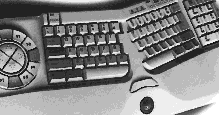
Cornell University Ergonomics Web


by Lillian Ng and Alan Hedge (1995)
PRESENTATION SLIDES OF THE RESEARCH STUDY
ABSTRACT
The objective of this study was to examine and compare the effects of an alternative ergonomic keyboard, a fixed-angle split design with a center trackball, and a traditional keyboard and a mouse on typing performance, wrist deviation, posture, and comfort. In the past decade, there has been a dramatic rise in the incidence of repetitive strain injuries (RSIs) in the workplace. Research suggests that wrist deviations from a neutral position increase the likelihood of developing carpal tunnel syndrome, the most common RSI of the wrist. This wrist disorder is caused by compression of the median nerve, resulting in motor and sensory dysfunction. Some of the risk factors associated with carpal tunnel syndrome include extreme wrist deviation, repetitive motions of the wrist, finger/wrist forces, gender, and individual hand characteristics.
A laboratory experiment was conducted with twelve female typists on an ergonomic fixed-angle split keyboard with a center trackball and a traditional keyboard and a mouse. Typing tasks, text entry, and cursor positioning trials were counterbalanced. Quantitative typing speed and accuracy were obtained from the Typing Tutor software that was used. A Gripmaster exoskeleton system was worn on the right wrist of each subject to dynamically measure wrist deviation at a sampling rate of 5 Hz. Video motion analysis captured upper body postural data and the Peak 2D software was used to calculate neck, elbow, wrist extension, and forearm pronation angles. Subjects rated each of the keyboards on typing speed, accuracy, comfort, preference, and musculoskeletal strain.
Results of this study failed to confirm any substantial benefits of the fixed-angle split keyboard (FASK) compared with the traditional keyboard (TK). Data for typing speed yielded a statistically significant decrease of almost five words per minute with the FASK. Similarly, there was a decrease of about 2% in typing accuracy with the FASK. Analyses of Gripmaster and video motion data found no statistically significant differences for wrist extension and ulnar deviation while typing. In addition, 3-D probability density plots showed no visual evidence of decreased wrist deviation with the FASK.
For cursor positioning trials, no significant differences were found for wrist extension or ulnar deviation dynamic measurement data, and
3-D probability density plots indicated no substantial postural benefits with the FASK trackball. To the contrary, these plots suggest that the trackball required a greater range of hand/wrist posture than did the mouse. Video motion analysis data showed a significant increase of 11.3° in wrist extension with the FASK trackball.
There was significantly greater neck bending while typing on the FASK but no difference was found during cursor positioning trials. Elbow angle difference was not statistically significant between keyboards while typing, but during cursor positioning, elbow angle was significantly decreased by 23° with the FASK trackball. There was no significant difference between keyboards for wrist pronation during typing and cursor positioning trials. 58% of subjects reported that the FASK was more comfortable and preferred to use it. Generally, musculoskeletal strain reports favored the FASK.
This study failed to confirm any objective postural benefits during short-term use of a fixed-angle split keyboard by trained typists. Different results might have been obtained over a longer period of use, or with untrained typists, or with those suffering from a wrist disorder. Therefore, the implications of this study are limited to the immediate effects of the keyboard. A larger scale long-term field experiment is necessary to evaluate any improvements with sustained use of a fixed-angle split keyboard.